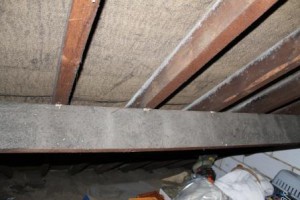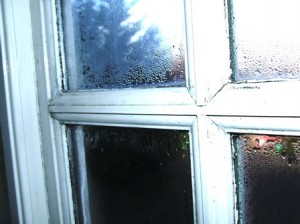 Recently we undertook an RICS Homebuyer’s Survey in Reading and found mildew staining to the underside of felt and roof timbers. It indicated that the roof ventilation was not adequate, causing moist air to condense on the cold surface on the underside of the roof covering.
Recently we undertook an RICS Homebuyer’s Survey in Reading and found mildew staining to the underside of felt and roof timbers. It indicated that the roof ventilation was not adequate, causing moist air to condense on the cold surface on the underside of the roof covering.
This defect is more and more common as building owners are taking advantage of government incentives to improve energy performance in properties, adding additional insulation in their roof spaces. However, if insulation installers are not careful they can block up gaps between rafters at the eaves and prevent the cross flow of ventilation through the roof void.
Ventilation in the roof space is important as it is required to ensure roof timbers are protected from such moisture and the resulting consequences.
A defect like this is not costly to remedy but needs immediate attention to prevent damage to the timber roof structure. Potentially we saved our clients thousands of pounds in future repairs were this defect left unnoticed.
If you’re in need of some advice on a property defect, a Homebuyer survey or building survey, contact us on 01635 579 208.
Lack of Ventilation leads to Mildew
Condensation
 The RMA Surveyors Ltd guide to condensation within buildings.
The RMA Surveyors Ltd guide to condensation within buildings.
One of the most widely misinterpreted and misunderstood building defects is condensation. It can often be confused with service leaks and external water penetration. The key to understanding how and why condensation occurs is surface temperature.
Condensation occurs because water vapour in the air can no longer be held by the air. The water vapour condenses and becomes liquid water.
The warmer the air, the more water vapour it can carry. When warm air comes into contact with a cold surface, air temperature is reduced and the volume of water vapour must also be reduced.
When condensation occurs it will manifest on surfaces colder than the surrounding air temperature. We are all familiar with condensation on windows. In most circumstances windows are usually the coldest surface on an external wall. When condensation occurs on other surfaces in a room it is usually a good indication that that surface is colder than other surrounding surfaces that are unaffected.
Mould and mildew associated with condensation is not always going to appear. The mould occurs only because the conditions for it to exist are present, namely a food source and moisture source. Moisture is provided courtesy of the condensation process. Food can be any organic material, including cellulose in emulsion paints and oil on fingers transferring to a wall or ceiling surface.
Often people attempt to clear away mould with a cloth end up with worse mould staining as organic material from the cloth creates a further food source for the mould to establish. There are a multitude of mould and mildew removal products on the market. In cases of condensation it is better to resolve the cause rather than just treat the symptoms.
Surface temperature alone is an oversimplification of the problem. The warmer the air the greater the capacity of water vapour. However, the quantity of water in the air is not always at full capacity all of the time. If that were the case almost every window would have condensation. Therefore the volume of moisture in the air, or relative humidity, is critical to each situation where condensation may arise. Understanding the relationship between the air’s relative humidity and the temperature at which air can no longer carry that volume of water vapour (otherwise known as the dew point), is critical to determining how to resolve a condensation problem.
To deal with condensation a number of options are available. All of the options simply require a difference in the parameters that allow condensation to occur.
Firstly, you can increase the surface temperature above the dew point. This could mean increasing insulation levels, providing secondary glazing or double glazing or providing a source of heat such as trace heating, like that on our car heated rear windows.
Increasing room temperatures also allows the air to carry a greater volume of water vapour, which, providing the relative humidity does not also increase, can alter the dew point and prevent condensation forming. This can be a rather arbitrary approach and is unlikely to be economical in terms of heating bills.
Altering insulation levels of external walls and roof structures can create condensation problems. There are many examples where blocks of flats and houses have had cavity wall insulation fitted and condensation problems have begun to manifest elsewhere. Localised spotting condensation can also occur in such cases. Where insulation has been unevenly distributed and the resulting gaps in insulation cause differential surface temperatures internally. Interstitial condensation can also occur. This happens when the dew point occurs within the wall or ceiling structure. Interstitial condensation can be a real problem as it can saturate the internal structure of a building elemnet for a long period before a defect begins to manifest itself. This is a particular problem in timber framed housing, when the internal vapour barrier within the wall structure has been damaged or poorly installed.
Secondly, you can reduce the amount of humidity in the air. This means isolating water sources. This is easier said than done. The fact that a property is inhabited by eating, breathing mammals who evaporate, perspire and respire their way throughout the day makes it difficult to reduce the amount of water vapour in a property. People tend to want to eat, boil kettles, wash and dry clothes, stay clean, use the toilet, keep pets and generally undertake activities that require the use of water, a proportion of which ends up as vapour carried within the air.
Reducing our use of water may not always be practical. Managing the way we use water can be. For example opening trickle vents on windows or keeping high humidity environments such as bathrooms and kitchens well ventilated with regular air changes from external air will help reduce relative humidity. Keeping toilet seat lids in the closed position will also contribute to reducing humidity.
Thirdly, good ventilation is also key to reducing the liklihood of condensation occurring. Where air is kept moving there is less likelihood of water vapour within the air condensing on cold surfaces. This is why opening a window, even only partially, can radically reduce instances of condensation as the water is yurned back to vapour and is carried off by unsaturated air.
Leaving condensation to establish long term can cause a multitude of problems both to the building and the individual. Mould spores can not only look unsightly but can affect human health. Associated respiratory illness is well documented with mildew moulds.
Condensation in buildings can result in longer term damp problems allowing dry and wet rots to develop and damage timber elements. As well as this surface decorations can be damaged and goods and furnishings can also be affected. Often clothing and stored goods in humid properties can be ruined, as condensation forms in wardrobes and moulds establish. Very humid properties are particularly prone as humid high pressure air forces its way into less humid cooler areas. Often such losses are not covered by standard insurance policies.
If you want to read more about condensation the RICS have produced this guidance note. Further information is also provided by the ISVA which is available here.
If you have a condensation problem and would like some further investigation and advice from RMA Surveyors Ltd please contact us and we will be happy to assist.



